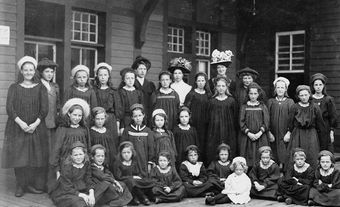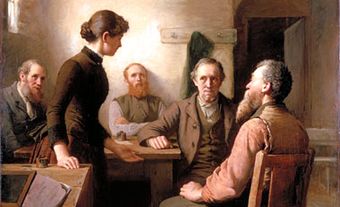Revolutionary Industrial Unionism
Revolutionary industrial unionism, or syndicalism, a broad international movement dedicated to organizing all workers into single, unified labour organizations designed to overthrow the capitalist system by means of industrial actions, including the general strike. In contrast with more orthodox socialism, communism or social democracy, the movement sought to establish direct workers' control over economic and political life through unions and workers' councils. Its best expression in Canada was the ONE BIG UNION (1919-56), a coalition of INDUSTRIAL WORKERS OF THE WORLD sympathizers, socialists and trade unionists. Unlike the American-based IWW and the WORKERS UNITY LEAGUE (1929-36), which had direct ties with the Communist International in Moscow, the OBU was a wholly indigenous Canadian organization, albeit aiming for membership in the United States as well, and gaining temporary support in such diverse locales as Butte, Montana, and Lawrence, Massachusetts.
Although preaching the general strike as a means to destroy capitalism, and fiercely denouncing the flaws of the parliamentary system, the movement did not completely eschew political action in the Canadian context. R.B. RUSSELL, OBU general secretary, W.A. Pritchard from Vancouver and others, stood for Parliament in 1921. John Angus McDonald was elected to Parliament for the OBU miners in northern Ontario in 1920; Phillip Martin Christophers was elected for the Alberta legislature for the OBU miners of the Crowsnest Pass in 1921.
In general, revolutionary unionism in Canada reflected an eclectic reading of syndicalist and socialist theory, as was appropriate to the diverse traditions and complex needs of its constituency. Canadian revolutionary unionism, in contrast to its British, German and even American counterparts, failed to make significant inroads into mass production industries (in theory its main targets). But until the 1930s it had solid backing in the forest and mining sectors, an influence long felt in such unions as the Mine, Mill and Smelter Workers and the International Woodworkers of America. It also attracted support from groups who felt estranged from the political-economic establishment on the one hand and the established labour movement on the other: non-English-speaking immigrants, farm workers, the unemployed. Finally, within the context of the OBU, revolutionary unionism briefly embraced skilled crafts workers, especially in 1919 in British Columbia and Manitoba.
Briefly after WWI it seemed that revolutionary unionism would seriously challenge or even destroy traditional patterns of industrial relations and union organization in Canada. War difficulties, including the bitter debate over CONSCRIPTION, induced a deep cleavage between eastern and western union leaders. The militant BC Federation of Labour had crossed swords continually with the majority ("eastern") bloc of the TRADES AND LABOR CONGRESS. When Albert "Ginger" GOODWIN, leader of the 1917 Trail strike, was shot and killed by a Dominion Police constable in July 1918, a one-day general strike was organized in Vancouver, and the BCFL leadership spearheaded the Western Labour Conference that advocated secession from the TLC in March 1919. The Dominion government only offered workers a royal commission, in April, to investigate the "causes of industrial unrest." Many western unionists simply boycotted the proceedings. The OBU was still organizing when the workers that its leaders claimed to represent rose independently: a one big union from below unleashed by the Canadian labour revolt in May and June of 1919. Government, employers and international union leaders collaborated in the ensuing repression. After the failure of the WINNIPEG GENERAL STRIKE the OBU's chance for a takeover in the labour movement had passed. Workers in federally controlled industries such as the Alberta coal mines of District 18 were coerced out of the OBU, and a challenge against discrimination by Canadian National Railways of Winnipeg's OBU shopcraft workers failed in the Privy Council case of Young v CNR in 1927.
During the 1920s, many of the IWW's and OBU's former sympathizers drifted into the COMMUNIST PARTY OF CANADA or the "Left Wing" in the TLC unions. Best known was J.B. MCLACHLAN from Glace Bay, NS, who was jailed for his efforts in the CAPE BRETON STRIKE. This experience contributed to the zeal with which McLachlan, Harvey Murphy, Tom McEwen, Annie BULLER and countless other Canadian radicals engaged in the last attempt to build a "revolutionary union central" in Canada during the 1930s: the Workers Unity League. The WUL had originated in the minds of the Toronto-based leadership of the Communist Party, but it evolved into a genuine workers' unity league, especially during 1932-34 when the party's leadership was incarcerated in Kingston Penitentiary. In 1933 a bona fide delegate convention saw significant revisions to the League's constitution; the independent-minded J.B. McLachlan served as president of the League.
The WUL, like the IWW and the OBU, failed to build a stable membership of more than a fraction of TLC affiliates, but it mobilized over 50 000 workers in strikes; accounting for 50% of all strikes and strikers in Canada in 1933-34. The WUL's penetration of southern Ontario's factory belt in those years was a new departure in the history of revolutionary unionism in Canada, and a signal of a force in Canadian industrial life that gained major momentum in 1937. The WUL's high point was 1934 when its militants led no less than 109 strikes. Three WUL-led coal miners were killed at Estevan, Saskatchewan in 1931; army machine-gun carriers were called to fight the WUL in Stratford, Ontario in 1933; brass knuckles and police cavalry were used against an allied organization on the Vancouver docks in 1935. The WUL fought for immediate demands, such as the "work and wages" sought by the 1935 ON TO OTTAWA trekkers. Its practical politics were not "revolutionary". An entire slate of WUL supporters was elected to town council in Blairmore, Alta, in 1933; typically recolouring old designs, they spruced up the main street and dubbed it Tim BUCK boulevard.
Revolutionary industrial unionism in North America did not really die during the Depression; rather, its advocates were co-opted into the orthodox political left or into the pragmatic CIO (Committee for Industrial Organization/Congress of Industrial Organizations). Most WUL militants merged with the US-based CIO unions in 1936. Fate was not kind to the revolutionary unionists in Canada, but the situation can be favourably contrasted with that in Europe, the movement's birthplace, where by 1940 their comrades in France, Italy, Germany, Spain and the USSR were behind the barbed wire of the dictators. The "revolutionary" side of the movement proved a chimaera. Its practical side was an effective program for labour, by which "we mean all those who by useful work of hand or brain, feed, clothe or shelter; or contribute towards the health, comfort and education of the human race" (OBU General Executive Board, Vancouver Bulletin No 1).
See also WORKING-CLASS HISTORY.

 Share on Facebook
Share on Facebook Share on X
Share on X Share by Email
Share by Email Share on Google Classroom
Share on Google Classroom


